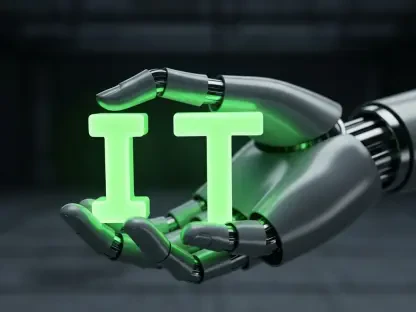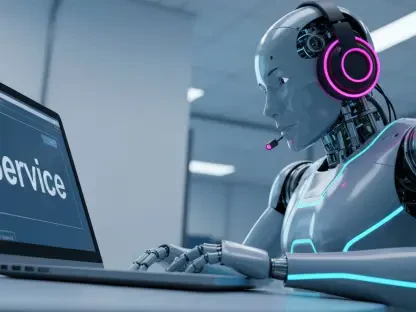The landscape of Site Reliability Engineering (SRE) is undergoing a seismic shift with the integration of Large Language Models (LLMs) into production systems, presenting a staggering reality that confronts the industry. Traditional runbooks, meticulously crafted for predictable, deterministic environments, are faltering under the unpredictable nature of generative AI, prompting a critical need for adaptation. This roundup dives into the heart of this disruption, gathering insights from various industry perspectives to explore how SREs are grappling with non-deterministic challenges and what strategies are emerging to ensure reliability in an AI-driven world. The purpose here is to synthesize diverse opinions and practical tips, offering a comprehensive view of this evolving field and actionable guidance for navigating uncharted territory.
Unpacking the Collision of AI and Site Reliability Engineering
The foundation of SRE has long rested on the predictability of systems, where standardized procedures ensure uptime and stability through well-defined responses to known issues. However, the rise of LLMs introduces a layer of complexity that defies such determinism, as these models often produce varying outputs for identical inputs. Industry voices highlight a growing concern that this unpredictability undermines the very principles SREs have relied upon for decades, pushing the need for adaptation into sharp focus.
As AI technologies become deeply embedded in critical production environments, the stakes for reliability have never been higher. Discussions across tech forums and conferences reveal a consensus that generative AI’s integration is not a distant concern but a present challenge, shaking the core of traditional practices. Many experts argue that without swift evolution in strategies, the risk of system failures could escalate significantly.
This roundup aims to dissect the specific disruptions LLMs bring to SRE runbooks by collating varied perspectives on the issue. It examines how the industry is responding to these shifts and explores potential pathways forward to maintain reliability amidst AI’s unpredictable nature. The insights gathered promise to shed light on both the hurdles and the innovative approaches shaping the future of this discipline.
Navigating the New Terrain of AI-Driven Reliability
The Unpredictability Problem of LLMs in Production
One of the most pressing issues with LLMs in production environments is their non-deterministic behavior, a stark contrast to the consistent outcomes expected in traditional systems. Industry leaders note that this randomness challenges conventional SRE metrics, such as HTTP status codes, which are ill-suited to gauge the health of AI-driven applications. The lack of predictability complicates incident response, leaving teams scrambling to interpret erratic outputs.
Further compounding this problem are data shifts that can destabilize AI systems, as observed during major global events like the COVID-19 crisis. Experts point to real-world instances where forecasting models failed due to sudden, unprecedented changes in data patterns, underscoring the fragility of current frameworks. Such examples illustrate the urgent need for new tools and methodologies to address these vulnerabilities.
A heated debate persists on whether existing SRE structures can evolve to accommodate the inherent uncertainty of generative AI. Some argue that stability in production remains non-negotiable, while others suggest that embracing a degree of randomness might be inevitable. This tension highlights a critical juncture for the field, where adaptation could either redefine reliability or expose systemic weaknesses.
From Model Training to Real-Time Inference Challenges
The focus of AI workloads has shifted dramatically from training models for accuracy to ensuring dependable inference in live settings. Industry insights emphasize that while training once dominated AI efforts, the remarkable capabilities of LLMs have pivoted attention to real-time performance. SREs now find themselves at the forefront, tasked with maintaining reliability under conditions that lack mature supporting tools.
This transition is evident in trends where companies increasingly rely on SREs to manage live inference challenges, often drawing from case studies of tech giants experimenting with AI vetting processes. Such examples reveal a growing responsibility for SREs to bridge the gap between theoretical model performance and practical deployment, navigating untested waters with limited precedents.
Balancing the risks of operating without established guidelines against the potential for innovation presents a unique opportunity. Early adopters who tackle inference-focused reliability stand to gain a competitive edge, as noted by several industry observers. However, the absence of standardized practices raises questions about scalability and long-term success, pushing SREs to pioneer solutions in real time.
Redefining Metrics and Observability for AI Systems
Monitoring LLMs demands a radical rethinking of traditional approaches, with emerging ideas centering on business outcomes as quality indicators, such as click-through rates in advertising platforms. Voices from the field suggest that these metrics, while unconventional for SREs, offer a tangible way to assess AI performance in the absence of deterministic signals. This shift signals a broader redefinition of what constitutes system health in AI contexts.
Global disparities in observability maturity add another layer of complexity, with data indicating that only about half of organizations possess adequate monitoring for machine learning models. This gap prompts discussions on integrating faster early-warning mechanisms to preempt issues before they escalate. The consensus leans toward a hybrid approach, combining business-level insights with system diagnostics for comprehensive oversight.
Challenging the notion that conventional metrics alone can suffice, many in the industry advocate for a wider lens on observability. AI’s unique demands might either expose longstanding gaps in monitoring practices or drive overdue improvements, depending on organizational readiness. This dual potential underscores the need for tailored frameworks that address both technical and strategic dimensions of reliability.
Balancing Ideal Solutions with Practical Constraints
Theoretically, tracking every component of an AI system—data, models, and policies—could provide full transparency into deviations, but practical limitations often render this unfeasible. Industry perspectives stress that the resource intensity and complexity of such comprehensive provenance tracking deter most organizations from pursuing it. This gap between ideal solutions and real-world constraints remains a persistent hurdle.
Differing opinions emerge on how to address this challenge, with some advocating for streamlined, resource-efficient methods to approximate ideal practices. Others caution that cutting corners might compromise reliability, urging a cautious balance. Speculation abounds on whether future innovations could yield leaner approaches that maintain rigor without overwhelming budgets or teams.
Beyond technical barriers, this issue carries strategic implications for SREs, who must redefine what “reliable enough” means in an AI context. The discussion reveals a broader shift in mindset, where pragmatism often trumps perfection. Navigating this tension will likely shape how reliability standards evolve over the coming years, as organizations weigh ambition against feasibility.
Key Lessons and Actionable Steps for SREs in the AI Era
Synthesizing the insights from various industry viewpoints, several critical takeaways emerge for SREs navigating AI’s impact. The unpredictability of LLMs has rendered traditional runbooks obsolete, while the shift to inference challenges demands a focus on real-time reliability. Additionally, the urgent need for evolved monitoring frameworks stands out as a unifying concern across different perspectives.
Practical steps for SREs include adopting business-outcome metrics to evaluate AI system performance, as these provide a relevant gauge where technical signals fall short. Investing in advanced observability tools tailored to machine learning workloads is another widely recommended action, aimed at closing the maturity gap. Cross-team collaboration between SREs and data scientists also surfaces as a key strategy to align technical and operational goals.
For those looking to get started, piloting hybrid monitoring frameworks that blend traditional and AI-specific metrics offers a low-risk entry point. Engaging with community-driven experiments in MLOps can further provide valuable insights and keep teams ahead of rapid developments. These actionable measures, drawn from diverse industry input, equip SREs to tackle immediate challenges while building toward long-term resilience.
Looking Ahead: The Future of Reliability in an AI-Driven World
Reflecting on the discussions that shaped this roundup, it becomes clear that the industry stands at a pivotal crossroads during this transformative period. LLMs have undeniably shattered old reliability paradigms, yet the establishment of new standards remains an ongoing endeavor. The collective insights gathered paint a picture of uncertainty paired with opportunity, as SREs work to adapt to non-deterministic systems.
Moving forward, actionable next steps emerge as vital considerations. Organizations are encouraged to prioritize experimentation with emerging tools and metrics, fostering environments where iterative learning can thrive. Additionally, building robust partnerships across technical domains promises to accelerate the development of cohesive reliability strategies, ensuring AI’s potential is harnessed without sacrificing stability.
As the journey toward production-grade AI reliability continues, potentially spanning several years, the adaptability demonstrated by SREs in these discussions will likely define the benchmarks of tomorrow. Embracing a mindset of innovation over rigid certainty stands out as a guiding principle, urging the industry to view challenges as catalysts for redefining what reliability means in this dynamic era.









